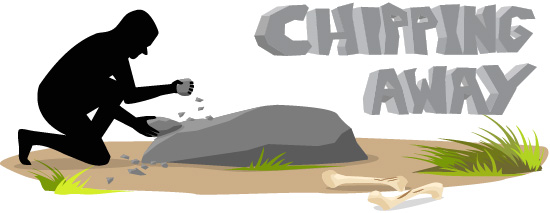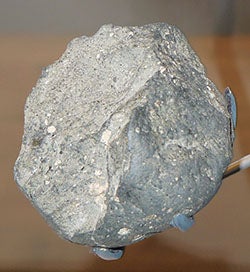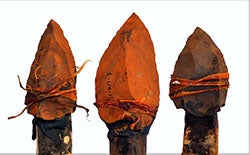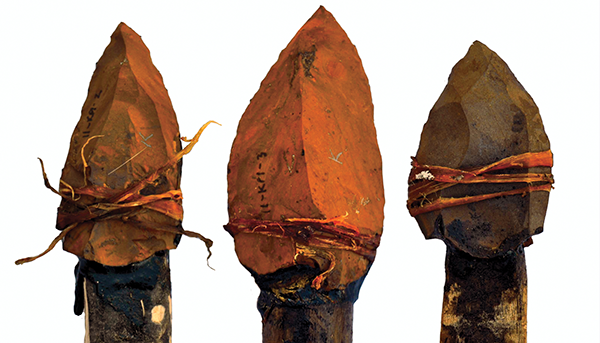
Chipping Away: Tools in the Stone Age
Tools in the Stone Age
 Time travel back to 2.3 million years ago. Tall grasses of the African savanna provide little shade for a four-and-a-half-foot-tall human ancestor that you see in the distance. The sun is hot above him, but the circling of vultures ahead holds the promise of a dead animal nearby and, most importantly, meat. He breaks a rock and picks up a shard of it about the size of his palm. It has a razor-sharp edge.
Time travel back to 2.3 million years ago. Tall grasses of the African savanna provide little shade for a four-and-a-half-foot-tall human ancestor that you see in the distance. The sun is hot above him, but the circling of vultures ahead holds the promise of a dead animal nearby and, most importantly, meat. He breaks a rock and picks up a shard of it about the size of his palm. It has a razor-sharp edge.
He strides forward past thorny trees and tall termite mounds. The smell of a rotting carcass soon fills his nostrils entirely. Stopping to check for signs of a lion or hyena at the kill, the hominin hastily closes in on a half-eaten antelope. He furiously cuts at the carcass with the sharp edge of the stone. He hurries because he knows that whatever hunted this animal could also be hunting him.
Quickly cutting strips of meat from the skeleton, he occasionally strikes bone. This can leave deep marks on the bone. As quickly as he found the animal, he leaves—carrying enough scraps of meat to feed his nearby small family group. The only evidence that anything happened there 2.3 million years ago are the cut-marked bones and a discarded stone tool.
Since long ago, the survival of our ancestors has depended in part on technology. Even today, the shoes you put on and the car you drive are both built on previous discoveries. We can trace human technological developments way back to over three million years ago. At that time, hominins in Africa made basic stone tools for cutting and pounding food.
The invention of invention
Humans use tools every day. Other animals also use tools. Tools are objects used to achieve a goal. In the animal world, birds, primates, elephants, and even octopuses have been seen using tools.
 One species of bird uses tools in amazing ways. New Caledonian crows have been seen shaping small twigs into hooks. The hooked end is then used in hard-to-reach holes in the ground or in logs to pull out small grubs and insects for food.
One species of bird uses tools in amazing ways. New Caledonian crows have been seen shaping small twigs into hooks. The hooked end is then used in hard-to-reach holes in the ground or in logs to pull out small grubs and insects for food.
Our earliest ancestors used simple tools similar to those used by modern primates. Chimpanzees have been seen using a long stick for termite "fishing." To do this, they remove the bark from a stick and then carefully slide the stick into a termite mound and wait for termites to climb onto it. They then quickly pull the stick out and eat the clinging insects off of it.
Unfortunately, wood tools do not survive very well through time. In fact, the earliest instance of tool use is not even a tool. Instead it is the marks from stones on antelope bones dating back about 100,000 years before the oldest stone tools we've found.
Older than Oldowan?
 When the same type of tool is found over a big area for a long time, anthropologists refer to this as an industry. The famous anthropologists Louis and Mary Leakey discovered an early tool industry in a deep valley at Olduvai Gorge in Tanzania. These simple stone tools are known as the Oldowan Industry and are at least 2.6 million years old. Oldowan tools are simple and made from hard, nearby stones. Making the tool, however, requires skill because the stone has to be hit in specific ways to break correctly.
When the same type of tool is found over a big area for a long time, anthropologists refer to this as an industry. The famous anthropologists Louis and Mary Leakey discovered an early tool industry in a deep valley at Olduvai Gorge in Tanzania. These simple stone tools are known as the Oldowan Industry and are at least 2.6 million years old. Oldowan tools are simple and made from hard, nearby stones. Making the tool, however, requires skill because the stone has to be hit in specific ways to break correctly.
Until very recently, scientists thought the Oldowan Industry were the oldest tools in the world. That view has been changed by the discovery of 3.3-million-year-old stone tools at a site called Lomekwi 3 in Kenya. The stone tools from Lomekwi 3 look different than Oldowan tools. Right now, there are many more questions than answers surrounding the Lomekwi tools. For example, anthropologists don’t know what species made the tools or if there are even older stone tools yet to be found. Anthropologists are actively making new discoveries to answer those questions.
The latest and greatest
Oldowan tools are found in Africa, between 2.6 and 1.8 million years old. After this time, global climates became drier and cooler. When climate changed, the available plants and animals that our ancestors depended on for survival also changed. So, what new technologies were used to meet these new challenges?
 A major advance occurred around 1.8 million years ago when large, teardrop-shaped cutting tools called handaxes were first made. Handaxes are key pieces of the Acheulean Industry. They are made by taking flakes off both sides of a rock in what is called bifacial flaking. Homo erectus likely took Acheulean technology along when the species left Africa.
A major advance occurred around 1.8 million years ago when large, teardrop-shaped cutting tools called handaxes were first made. Handaxes are key pieces of the Acheulean Industry. They are made by taking flakes off both sides of a rock in what is called bifacial flaking. Homo erectus likely took Acheulean technology along when the species left Africa.
About 500,000 years ago, Acheulean technology began to disappear, and our ancestors started making tools using a trickier method. The Levallois technique was an important development, as flakes of an exact size and shape could be made. This is useful for many reasons, but the ability to attach flakes to a handle may have been one of the best. Putting flakes onto a handle (called “hafting”) is much safer than simply holding sharp tools. It also lets you attack your prey from a distance.
Technology addicts
Today, phones and computers occupy every part of our days. Is it surprising that we would be so dependent on these inventions? Humans have evolved alongside technology for at least 3.4 million years. We seem to be well adapted to making and using tools in order to survive. Maybe this explains why we feel lost without our phones or laptops—they are part of our industrial legacy!
Bibliographic Details
- Article: Chipping Away: Tools in the Stone Age
- Author(s): Benjamin J. Schoville
- Publisher: Arizona State University Institute of Human Origins Ask An Anthropologist
- Site name: ASU - Ask An Anthropologist
- Date published:
- Date modified:
- Date accessed: December 17, 2025
- Link: https://askananthropologist.asu.edu/stories/chipping-away-tools-stone-age
APA Style
Benjamin J. Schoville. (). Chipping Away: Tools in the Stone Age. Retrieved 2025, Dec 17, from {{ view_node }}
American Psychological Association, 6th ed., 2nd printing, 2009.
For more info, see the
APA citation guide.
Chicago Manual of Style
Benjamin J. Schoville. "Chipping Away: Tools in the Stone Age." ASU - Ask An Anthropologist. Published . Last modified . https://askananthropologist.asu.edu/stories/chipping-away-tools-stone-age.
Chicago Manual of Style, 17th ed., 2017.
For more info, see the
Chicago Manual citation guide.
MLA Style
Benjamin J. Schoville. Chipping Away: Tools in the Stone Age. ASU - Ask An Anthropologist. , {{ view_node }}. Accessed December 17, 2025.
Modern Language Association, 8th ed., 2016.
For more info, see the
MLA citation guide.
Be Part of
Ask An Anthropologist
By volunteering, or simply sending us feedback on the site. Scientists, teachers, writers, illustrators, and translators are all important to the program. If you are interested in helping with the website we have a volunteers page to get the process started.

